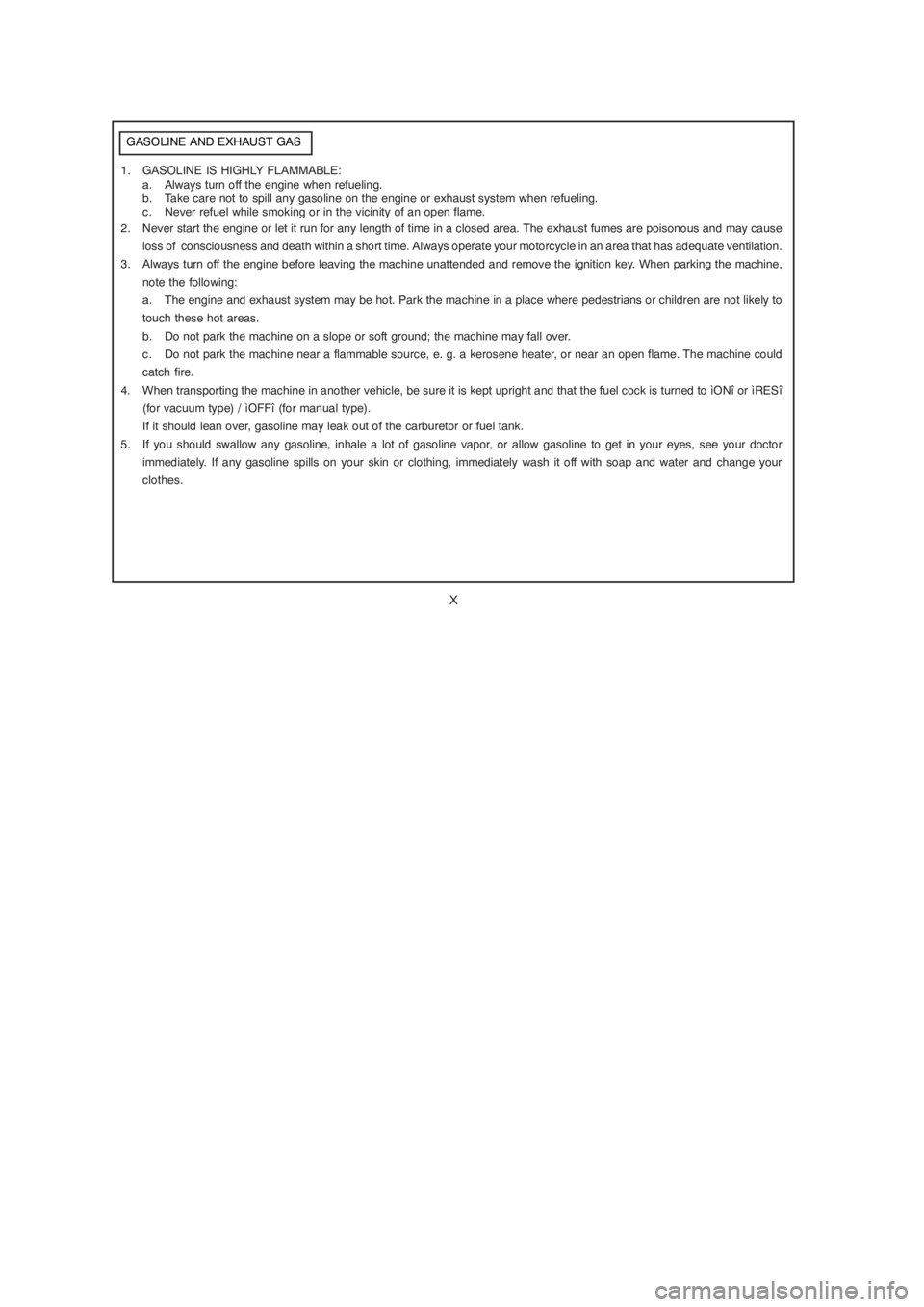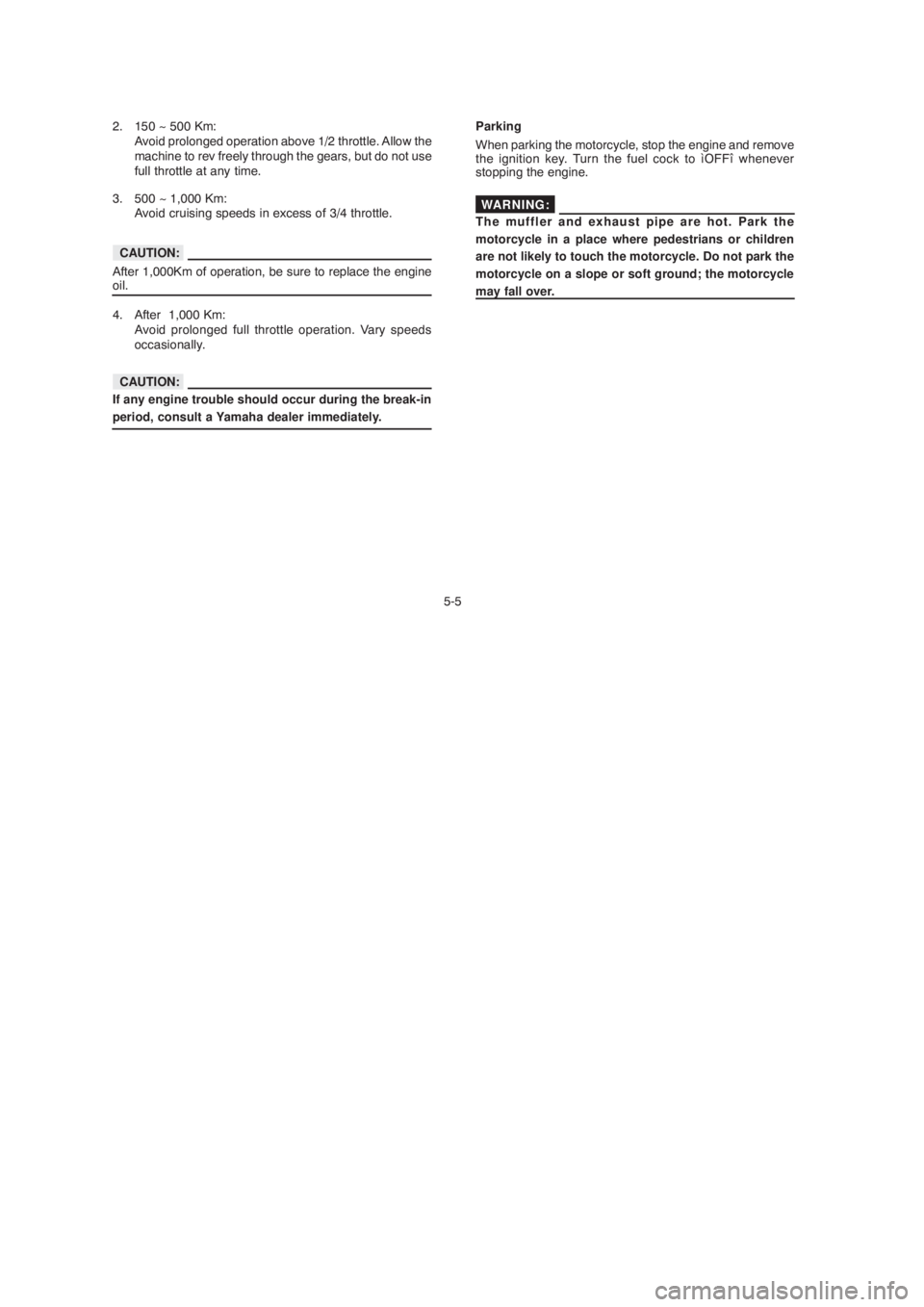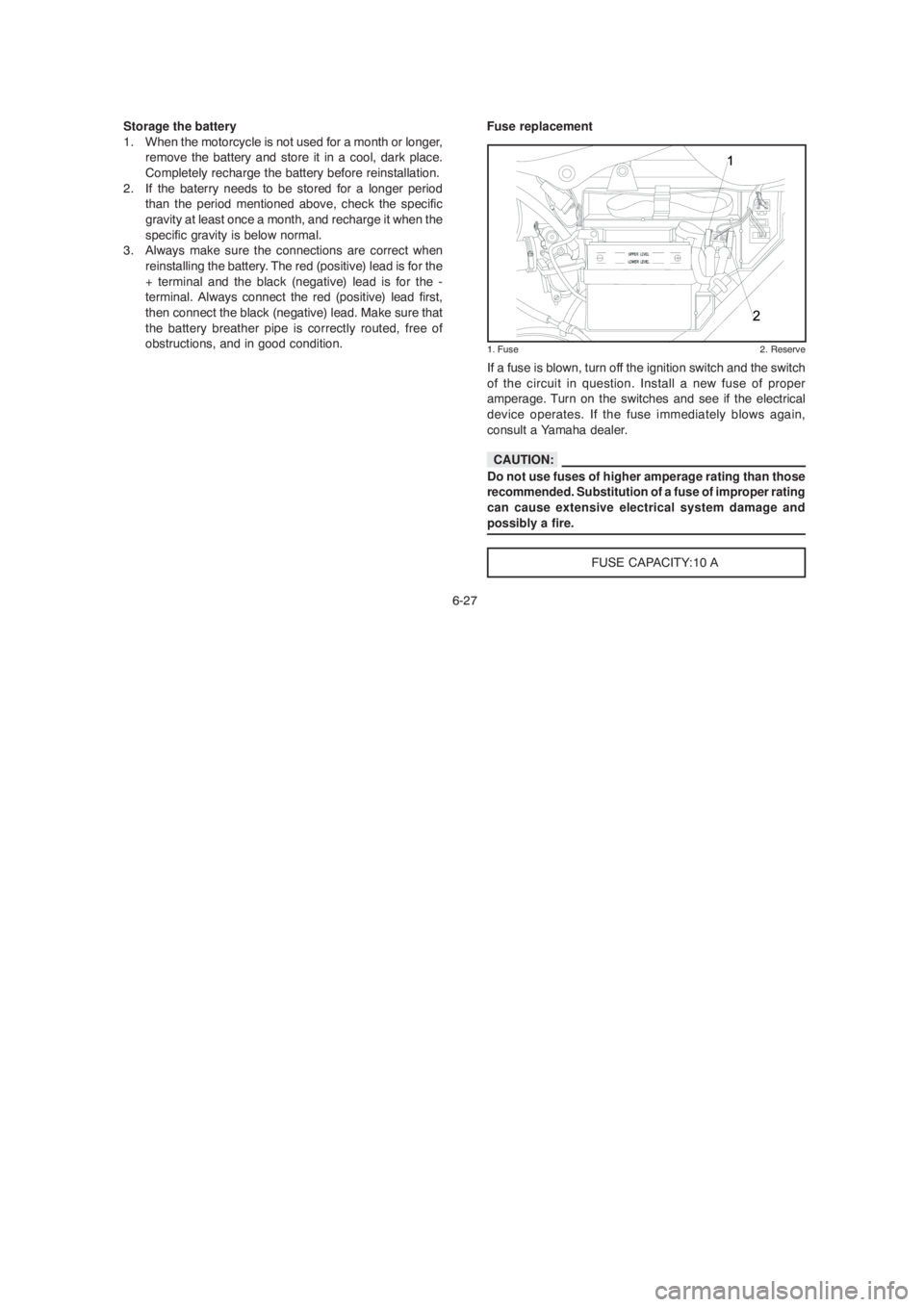2004 YAMAHA YBR125 ignition
[x] Cancel search: ignitionPage 10 of 83

X
GASOLINE AND EXHAUST GAS
1. GASOLINE IS HIGHLY FLAMMABLE:
a. Always turn off the engine when refueling.
b. Take care not to spill any gasoline on the engine or exhaust system when refueling.
c. Never refuel while smoking or in the vicinity of an open flame.
2. Never start the engine or let it run for any length of time in a closed area. The exhaust fumes are poisonous and may cause
loss of consciousness and death within a short time. Always operate your motorcycle in an area that has adequate ventilation.
3. Always turn off the engine before leaving the machine unattended and remove the ignition key. When parking the machine,
note the following:
a. The engine and exhaust system may be hot. Park the machine in a place where pedestrians or children are not likely to
touch these hot areas.
b. Do not park the machine on a slope or soft ground; the machine may fall over.
c. Do not park the machine near a flammable source, e. g. a kerosene heater, or near an open flame. The machine could
catch fire.
4. When transporting the machine in another vehicle, be sure it is kept upright and that the fuel cock is turned to ìONî or ìRESî
(for vacuum type) / ìOFFî (for manual type).
If it should lean over, gasoline may leak out of the carburetor or fuel tank.
5. If you should swallow any gasoline, inhale a lot of gasoline vapor, or allow gasoline to get in your eyes, see your doctor
immediately. If any gasoline spills on your skin or clothing, immediately wash it off with soap and water and change your
clothes.
X
GASOLINE AND EXHAUST GAS
1. GASOLINE IS HIGHLY FLAMMABLE:
a. Always turn off the engine when refueling.
b. Take care not to spill any gasoline on the engine or exhaust system when refueling.
c. Never refuel while smoking or in the vicinity of an open flame.
2. Never start the engine or let it run for any length of time in a closed area. The exhaust fumes are poisonous and may cause
loss of consciousness and death within a short time. Always operate your motorcycle in an area that has adequate ventilation.
3. Always turn off the engine before leaving the machine unattended and remove the ignition key. When parking the machine,
note the following:
a. The engine and exhaust system may be hot. Park the machine in a place where pedestrians or children are not likely to
touch these hot areas.
b. Do not park the machine on a slope or soft ground; the machine may fall over.
c. Do not park the machine near a flammable source, e. g. a kerosene heater, or near an open flame. The machine could
catch fire.
4. When transporting the machine in another vehicle, be sure it is kept upright and that the fuel cock is turned to ìONî or ìRESî
(for vacuum type) / ìOFFî (for manual type).
If it should lean over, gasoline may leak out of the carburetor or fuel tank.
5. If you should swallow any gasoline, inhale a lot of gasoline vapor, or allow gasoline to get in your eyes, see your doctor
immediately. If any gasoline spills on your skin or clothing, immediately wash it off with soap and water and change your
clothes.
Page 15 of 83

3-1
CONTROL FUNCTIONS
Main switch
The main switch controls the ignition and the electrical
system. Itís operation is described below.
ON:
Electrical circuits are switched on. Engine can be started.
The key cannot be removed.
OFF:
All electrical circuits are switched off. The key can be
removed.
LOCK:
The steering is locked and all electrical circuits are switched
off. The key can be removed. Refer to page (3-11) ìSteering
lockî for instructions.
NOTE:
Always turn the main switch to ìOFFî or ìLOCKî and remove
the key when the motorcycle is unattended.
3-1
CONTROL FUNCTIONS
Main switch
The main switch controls the ignition and the electrical
system. Itís operation is described below.
ON:
Electrical circuits are switched on. Engine can be started.
The key cannot be removed.
OFF:
All electrical circuits are switched off. The key can be
removed.
LOCK:
The steering is locked and all electrical circuits are switched
off. The key can be removed. Refer to page (3-11) ìSteering
lockî for instructions.
NOTE:
Always turn the main switch to ìOFFî or ìLOCKî and remove
the key when the motorcycle is unattended.
Page 40 of 83

5-5 2. 150 ~ 500 Km:
Avoid prolonged operation above 1/2 throttle. Allow the
machine to rev freely through the gears, but do not use
full throttle at any time.
3. 500 ~ 1,000 Km:
Avoid cruising speeds in excess of 3/4 throttle.
After 1,000Km of operation, be sure to replace the engine
oil.
4. After 1,000 Km:
Avoid prolonged full throttle operation. Vary speeds
occasionally.
If any engine trouble should occur during the break-in
period, consult a Yamaha dealer immediately.Parking
When parking the motorcycle, stop the engine and remove
the ignition key. Turn the fuel cock to ìOFFî whenever
stopping the engine.
The muffler and exhaust pipe are hot. Park the
motorcycle in a place where pedestrians or children
are not likely to touch the motorcycle. Do not park the
motorcycle on a slope or soft ground; the motorcycle
may fall over.
CAUTION:
CAUTION:
WARNING:
5-5 2. 150 ~ 500 Km:
Avoid prolonged operation above 1/2 throttle. Allow the
machine to rev freely through the gears, but do not use
full throttle at any time.
3. 500 ~ 1,000 Km:
Avoid cruising speeds in excess of 3/4 throttle.
After 1,000Km of operation, be sure to replace the engine
oil.
4. After 1,000 Km:
Avoid prolonged full throttle operation. Vary speeds
occasionally.
If any engine trouble should occur during the break-in
period, consult a Yamaha dealer immediately.Parking
When parking the motorcycle, stop the engine and remove
the ignition key. Turn the fuel cock to ìOFFî whenever
stopping the engine.
The muffler and exhaust pipe are hot. Park the
motorcycle in a place where pedestrians or children
are not likely to touch the motorcycle. Do not park the
motorcycle on a slope or soft ground; the motorcycle
may fall over.
CAUTION:
CAUTION:
WARNING:
Page 67 of 83

Storage the battery
1. When the motorcycle is not used for a month or longer,
remove the battery and store it in a cool, dark place.
Completely recharge the battery before reinstallation.
2. If the baterry needs to be stored for a longer period
than the period mentioned above, check the specific
gravity at least once a month, and recharge it when the
specific gravity is below normal.
3. Always make sure the connections are correct when
reinstalling the battery. The red (positive) lead is for the
+ terminal and the black (negative) lead is for the -
terminal. Always connect the red (positive) lead first,
then connect the black (negative) lead. Make sure that
the battery breather pipe is correctly routed, free of
obstructions, and in good condition.
6-27
If a fuse is blown, turn off the ignition switch and the switch
of the circuit in question. Install a new fuse of proper
amperage. Turn on the switches and see if the electrical
device operates. If the fuse immediately blows again,
consult a Yamaha dealer.
WARNING:
Do not use fuses of higher amperage rating than those
recommended. Substitution of a fuse of improper rating
can cause extensive electrical system damage and
possibly a fire.
FUSE CAPACITY:10 A Fuse replacement
1. Fuse 2. Reserve
CAUTION:
Storage the battery
1. When the motorcycle is not used for a month or longer,
remove the battery and store it in a cool, dark place.
Completely recharge the battery before reinstallation.
2. If the baterry needs to be stored for a longer period
than the period mentioned above, check the specific
gravity at least once a month, and recharge it when the
specific gravity is below normal.
3. Always make sure the connections are correct when
reinstalling the battery. The red (positive) lead is for the
+ terminal and the black (negative) lead is for the -
terminal. Always connect the red (positive) lead first,
then connect the black (negative) lead. Make sure that
the battery breather pipe is correctly routed, free of
obstructions, and in good condition.
6-27
If a fuse is blown, turn off the ignition switch and the switch
of the circuit in question. Install a new fuse of proper
amperage. Turn on the switches and see if the electrical
device operates. If the fuse immediately blows again,
consult a Yamaha dealer.
WARNING:
Do not use fuses of higher amperage rating than those
recommended. Substitution of a fuse of improper rating
can cause extensive electrical system damage and
possibly a fire.
FUSE CAPACITY:10 A Fuse replacement
1. Fuse 2. Reserve
CAUTION:
Page 74 of 83

6-34 Troubleshooting
Although Yamaha motorcycles receive a rigid inspection
before shipment from the factory, trouble may occur during
operation. Any problem in the fuel, compression, or ignition
systems can cause poor starting and loss of power. The
troubleshooting chart describes a quick, easy, procedure
for making checks. If your motorcycle requires any repair,
bring it to a Yamaha dealer. The skilled technicians at a
Yamaha dealership have the tools, experience, and know-
how to properly service your motorcycle. Use only genuine
Yamaha parts on your motorcycle. Imitation parts may look
like Yamaha parts, but they are often inferior. Consequently,
they have a shorter service life and can lead to expensive
repair bills.
6-34 Troubleshooting
Although Yamaha motorcycles receive a rigid inspection
before shipment from the factory, trouble may occur during
operation. Any problem in the fuel, compression, or ignition
systems can cause poor starting and loss of power. The
troubleshooting chart describes a quick, easy, procedure
for making checks. If your motorcycle requires any repair,
bring it to a Yamaha dealer. The skilled technicians at a
Yamaha dealership have the tools, experience, and know-
how to properly service your motorcycle. Use only genuine
Yamaha parts on your motorcycle. Imitation parts may look
like Yamaha parts, but they are often inferior. Consequently,
they have a shorter service life and can lead to expensive
repair bills.
Page 75 of 83

6-35Never check the fuel system while smoking or in the
vicinity of an open flame.
Check if there is
fuel in the fuel
tank
Use electric
starter
Remove spark
plug and check
electrode 1. Fuel
2. Compression
3. IgnitionEnough fuel
No fuel
There is compression
No compression
Wet
DrySupply fuel
Go to ignition check
Ask Yamaha dealer to inspect
Wipe clean with dry cloth and correct
spark plug gap or replace spark plugs
Ask Yamaha dealer to inspect
Troubleshooting chart
Go to compression
check
Engine doesnít start, go
to compression check
Open the throttle hal-way
and start the engine
Engine doesnít start,
go to battery check
WARNING:
6-35Never check the fuel system while smoking or in the
vicinity of an open flame.
Check if there is
fuel in the fuel
tank
Use electric
starter
Remove spark
plug and check
electrode 1. Fuel
2. Compression
3. IgnitionEnough fuel
No fuel
There is compression
No compression
Wet
DrySupply fuel
Go to ignition check
Ask Yamaha dealer to inspect
Wipe clean with dry cloth and correct
spark plug gap or replace spark plugs
Ask Yamaha dealer to inspect
Troubleshooting chart
Go to compression
check
Engine doesnít start, go
to compression check
Open the throttle hal-way
and start the engine
Engine doesnít start,
go to battery check
WARNING:
Page 77 of 83

7-2 B. STORAGE
Long term storage (30 days or more) of your machine will
require some preventive procedures to guard against
deterioration. After thoroughly cleaning the machine,
prepare for storage as follows:
1. Drain the fuel tank, fuel lines, and carburetor float
bowl(s).
2. Remove the spark plug(s), pour about one tablespoon
of SAE 20W50 motor oil in the spark plug hole(s) and
reinstall the spark plug(s).
Kick the engine over several times (with the
ignition off) to coat the cylinder walls with oil.
3. Remove the drive chain. Clean it thoroughly with
solvent and lubricate it.
Reinstall the chain or store it in a plastic bag
(tied to frame for safe-keeping).
4. Lubricate all control cables.
5. Block up the frame to raise both wheels off the
ground.
6. Tie a plastic bag over the exhaust pipe outlet to
prevent moisture from entering.7. If storing in a humid or salt-air atmosphere, coat
all exposed metal surfaces with a light film of
oil. Do not apply oil to any rubber parts or the
seat cover.
8. Remove the battery and charge it. Store it in a dry place
and recharge it once a month. Do not store the battery
in an excessively warm or cold place (less than 0∫C
(30∫F) or more than 30∫C (90∫F).
NOTE:
Make any necessary repairs before storing the machine.
7-2 B. STORAGE
Long term storage (30 days or more) of your machine will
require some preventive procedures to guard against
deterioration. After thoroughly cleaning the machine,
prepare for storage as follows:
1. Drain the fuel tank, fuel lines, and carburetor float
bowl(s).
2. Remove the spark plug(s), pour about one tablespoon
of SAE 20W50 motor oil in the spark plug hole(s) and
reinstall the spark plug(s).
Kick the engine over several times (with the
ignition off) to coat the cylinder walls with oil.
3. Remove the drive chain. Clean it thoroughly with
solvent and lubricate it.
Reinstall the chain or store it in a plastic bag
(tied to frame for safe-keeping).
4. Lubricate all control cables.
5. Block up the frame to raise both wheels off the
ground.
6. Tie a plastic bag over the exhaust pipe outlet to
prevent moisture from entering.7. If storing in a humid or salt-air atmosphere, coat
all exposed metal surfaces with a light film of
oil. Do not apply oil to any rubber parts or the
seat cover.
8. Remove the battery and charge it. Store it in a dry place
and recharge it once a month. Do not store the battery
in an excessively warm or cold place (less than 0∫C
(30∫F) or more than 30∫C (90∫F).
NOTE:
Make any necessary repairs before storing the machine.
Page 81 of 83

8-4
MODEL YBR 125K
Brakes:
Front brake type Drum brake
Operation Right hand operation
Rear brake type Drum brake
Operation Right foot operation
Suspension:
Front Telescopic fork
Rear Swingarm (New monocross suspension)
Shock absorber:
Front Coil spring, Oil damper
Rear Gas, Coil spring, Oil damper
Front 120 mm ( 5.0 in)
Rear 105 mm ( 4.0 in)
Electrical:
Ignition system CDI
Generator system AC Magneto generator
Battery type / capacity 12N 5,5-3B / 12V 5,5 Ah
8-4
MODEL YBR 125K
Brakes:
Front brake type Drum brake
Operation Right hand operation
Rear brake type Drum brake
Operation Right foot operation
Suspension:
Front Telescopic fork
Rear Swingarm (New monocross suspension)
Shock absorber:
Front Coil spring, Oil damper
Rear Gas, Coil spring, Oil damper
Front 120 mm ( 5.0 in)
Rear 105 mm ( 4.0 in)
Electrical:
Ignition system CDI
Generator system AC Magneto generator
Battery type / capacity 12N 5,5-3B / 12V 5,5 Ah